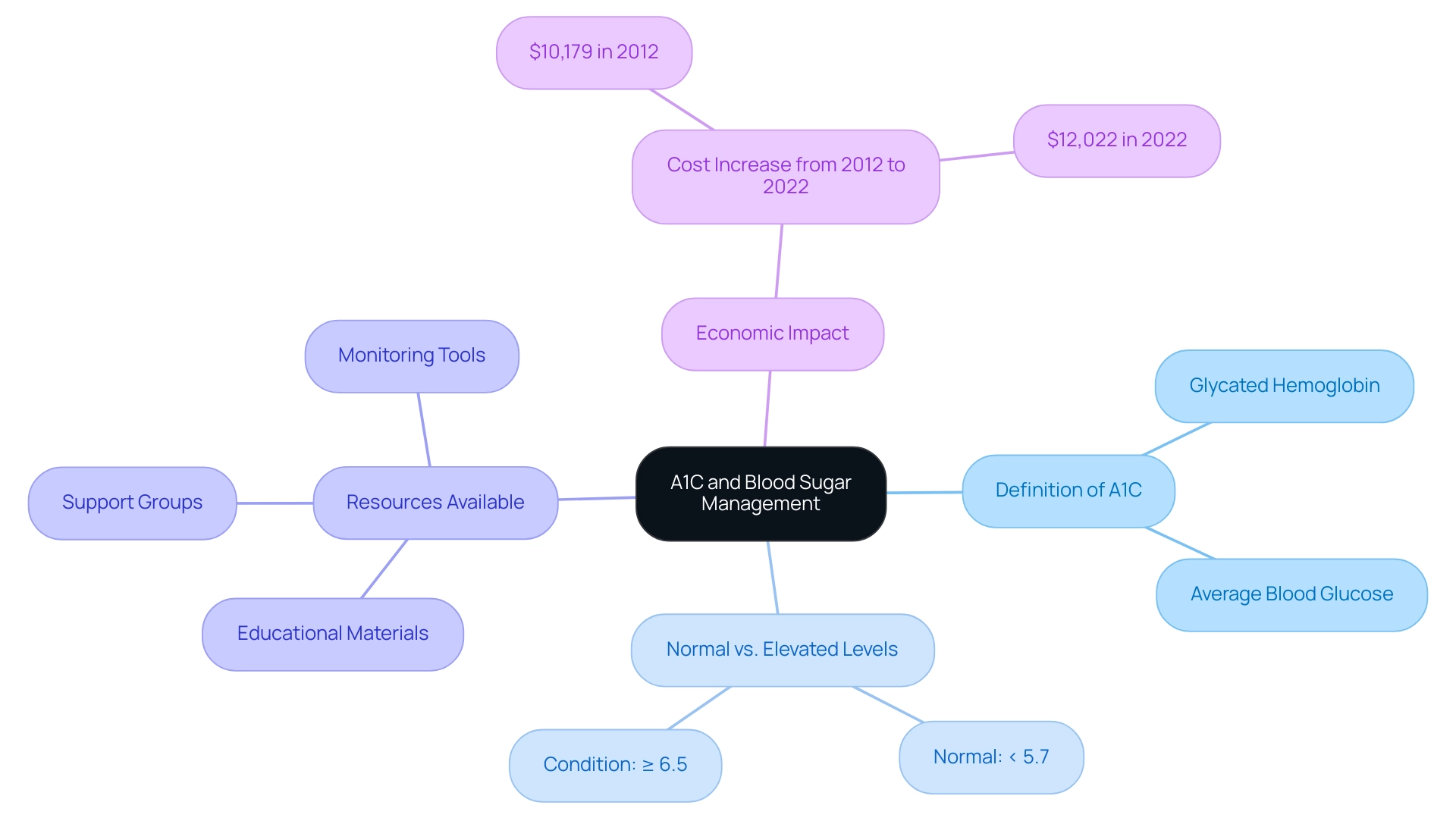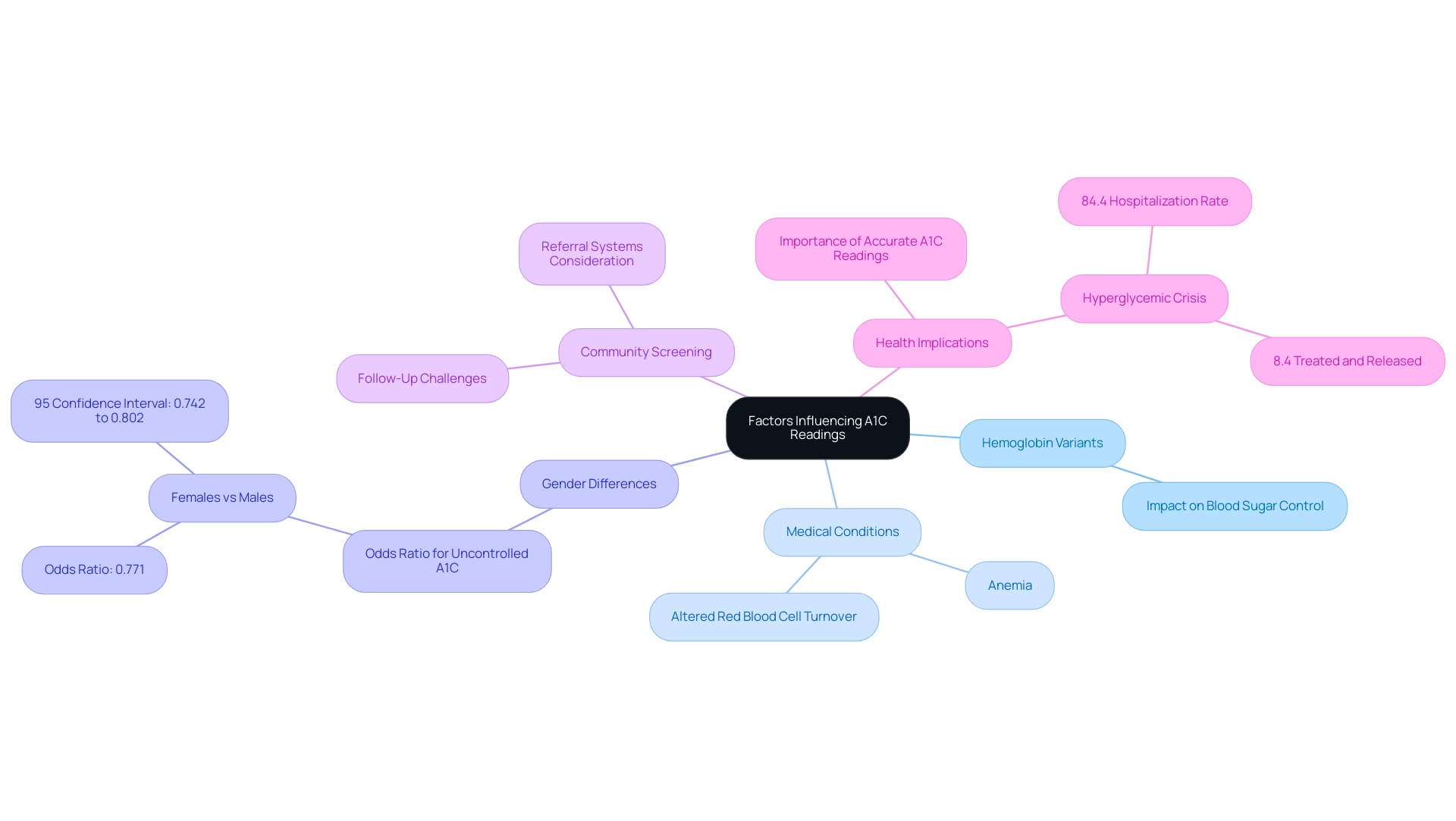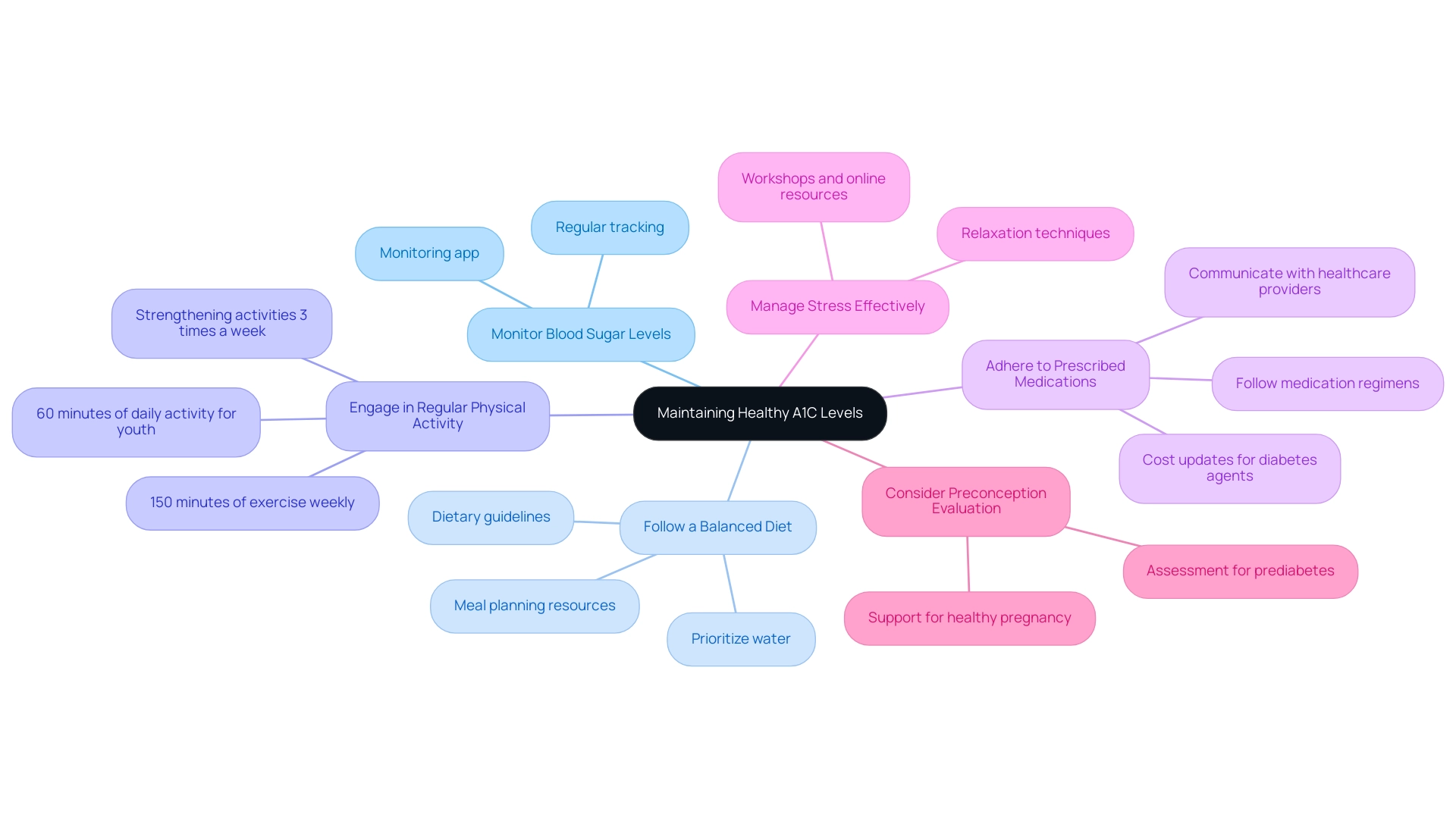Overview:
The article provides a step-by-step guide for converting A1C values to blood sugar levels, emphasizing the importance of this conversion for diabetes management. It supports this by presenting the formula for conversion and explaining how understanding these values helps individuals monitor their glucose control effectively, which is crucial for making informed health decisions.
Introduction
In the realm of diabetes management, understanding A1C levels is crucial for maintaining optimal health. A1C, or glycated hemoglobin, serves as a key indicator of average blood glucose levels over the past two to three months, providing valuable insights into an individual’s diabetes control.
With diabetes prevalence on the rise, the significance of monitoring A1C cannot be overstated, as it directly impacts treatment decisions and lifestyle adjustments.
The newly launched T2DSolutions resource hub aims to empower individuals with diabetes through education and support, offering tools for tracking A1C levels and guidance on effective management strategies.
This article delves into the importance of A1C, how to convert these values to daily blood sugar levels, factors influencing A1C readings, and practical tips for maintaining healthy levels, ensuring that individuals are well-equipped to navigate their diabetes journey.
Understanding A1C: What It Is and Why It Matters
A1C, or glycated hemoglobin, functions as a crucial blood test that indicates an individual’s average blood glucose readings over the prior two to three months. This measurement is expressed as a percentage; thus, higher percentages indicate elevated blood sugar readings. For individuals diagnosed with this condition, monitoring A1C to blood sugar levels is a crucial marker of how effectively blood sugar is managed over time.
Generally, a normal A1C reading is below 5.7%, while levels of 6.5% or higher indicate the condition. As the newly launched Td Solutions resource hub for Type 2 and Type 3 health education emphasizes, understanding your A1C results is imperative. This knowledge empowers individuals to make informed choices regarding their health management plans, ensuring they remain proactive in controlling their condition.
T2DSolutions will provide a variety of resources, including:
- Educational materials
- Support groups
- Tools for monitoring A1C values
These resources are specifically created to help newly diagnosed patients. Given the rising prevalence of the condition—evident in the increase from 9.7% to 14.3% in total cases from 1999-2000 to 2023—monitoring A1C levels is crucial. The economic consequences of dealing with the condition are substantial, with additional healthcare expenses per individual increasing from $10,179 in 2012 to $12,022 in 2022, highlighting this significance.
As Shannon Krohe from Novo Nordisk Inc. states, the importance of A1C to blood sugar levels in controlling them cannot be overstated, as it serves as a cornerstone for effective intervention strategies. Furthermore, the anticipated change in blood sugar condition prevalence rates by state by 2030 emphasizes the continuous necessity for effective A1C monitoring and oversight strategies.

Step-by-Step Guide to Converting A1C to Blood Sugar Levels
Introducing T2DSolutions, your comprehensive resource for Type 2 and Type 3 blood sugar management education and community support. As you navigate your diabetes management journey, understanding how to convert A1C values to blood sugar levels is essential. You can utilize the formula:
eAG (mg/dL) = (A1C x 28.7) - 46.7
For instance, if your A1C is 7.0%, the calculation would be as follows:
(7.0 x 28.7) - 46.7 = 158.9 mg/dL
This conversion is essential as it translates the percentage of hemoglobin A1C into a more comprehensible figure that reflects daily glucose amounts. Many healthcare providers also utilize simple conversion charts that connect A1C percentages with their corresponding average blood sugar readings.
Comprehending your eAG is essential for effective diabetes oversight, as it allows you to monitor the relationship of your A1C to blood sugar levels and how it affects daily glucose control. This knowledge is particularly significant given that a study of 254 individuals found participants spent 97% of their time within the optimal range of 70-140 mg/dL, underscoring the importance of maintaining stable blood sugar levels. As Vivian Fonseca highlighted in her editorial on hemoglobin A1C, translating these values is crucial for patient comprehension and care.
Additionally, research titled 'Meal Timing and Diabetes Risk' suggests that consuming large portions of daily calories after 5 p.m. may elevate the risk of developing this condition, further emphasizing that various factors influence blood glucose control. Stay tuned for more resources and updates from T2DSolutions as we strive to support your health management journey. We encourage you to subscribe to our newsletter to receive the latest information and resources as they become available, helping you stay informed and empowered in your health management.

Factors Influencing A1C Readings and Their Implications
A1C readings can be influenced by various factors, notably hemoglobin variants and specific medical conditions, including anemia. These factors can lead to misleading results; for example, individuals with altered red blood cell turnover may exhibit A1C levels that do not accurately reflect their blood glucose control. Recent findings emphasize that hemoglobin variants are prevalent among individuals with blood sugar issues and can impact the A1C to blood sugar levels measurements.
The odds ratio for uncontrolled A1C for females compared to males is 0.771, with a 95% confidence interval of 0.742 to 0.802, highlighting gender differences in A1C outcomes. The American Diabetes Association Professional Practice Committee asserts, 'There remains strong consensus that establishing a uniform approach to diagnosing GDM will benefit people with GDM, caregivers, and policymakers.' Moreover, a case study on hyperglycemic crisis emergency visits showed that 84.4% of patients were hospitalized, highlighting the seriousness of health issues related to glucose levels and the inaccuracies of A1C to blood sugar levels results.
Significantly, A1C offers a long-term average of blood sugar levels instead of instant feedback, emphasizing the importance of addressing any concerns related to A1C to blood sugar levels with healthcare professionals to ensure effective health oversight. Furthermore, community screening is generally not recommended due to follow-up challenges, emphasizing the significance of precise A1C to blood sugar levels readings in managing blood sugar. With the launch of T2D Solutions, we aim to provide newly diagnosed patients with comprehensive resources and community support, ensuring that they have access to accurate information about A1C and condition oversight, including how to interpret their readings and the implications for their health.

The Role of A1C in Ongoing Diabetes Management
Consistent tracking of A1C readings is crucial for efficient management of A1C to blood sugar levels. Current recommendations suggest that healthcare providers monitor A1C measurements every three to six months, customized to individual treatment goals. A1C results play a critical role in guiding treatment decisions, particularly in relation to A1C to blood sugar levels, including necessary adjustments to medications and lifestyle modifications.
As stated by Roopa Naik, 'Comprehending A1C values is crucial for patients to control their condition effectively.' By keeping A1C to blood sugar levels within the target range, individuals can significantly reduce the risks of complications related to diabetes, such as cardiovascular disease, nerve damage, and kidney dysfunction. Significantly, recent research shows that about 31.9% of U.S. adults aged 18 and above with diagnosed sugar-related conditions are physically inactive, highlighting the necessity of incorporating physical activity into care strategies.
T2DSolutions seeks to offer recently diagnosed individuals extensive resources and assistance in comprehending these vital elements of managing their condition, such as:
- Educational materials
- Access to support groups
- Tools for monitoring A1C rates
Furthermore, an international consensus led by Danne et al. emphasizes the importance of continuous glucose monitoring, which can provide more responsive data for treatment adjustments.
Healthcare professionals are also urged to prevent hypoglycemia and avoid overly aggressive A1C targets in patients where such targets cannot be safely achieved. Additionally, recent case studies, such as the one titled 'Cost Updates for Diabetes Agents,' highlight the financial considerations that can impact treatment planning. As a result, comprehending and efficiently controlling A1C values is crucial for thriving with the condition, particularly as the most recent guidelines for A1C to blood sugar levels testing frequency in 2024 emphasize the necessity for consistent monitoring.
As T2DSolutions launches, it will serve as a valuable hub for patients seeking guidance and support in their diabetes journey, offering them the tools they need to manage their condition effectively.

Tips for Maintaining Healthy A1C Levels
To sustain healthy A1C measures, it is crucial to embrace a thorough strategy that includes lifestyle changes and medical supervision, particularly in managing A1C to blood sugar levels. T2DSolutions is committed to empowering individuals through education and community support, providing resources such as monitoring apps, dietary guidelines, and access to support groups that can assist in this journey. Consider the following strategies:
- Monitor Blood Sugar Levels: Regularly tracking blood glucose levels is crucial for identifying patterns that can inform dietary and medication adjustments. T2DSolutions offers tools and resources, including a blood sugar monitoring app, to help you with this monitoring.
- Follow a Balanced Diet: Emphasize a diet rich in whole grains, fruits, vegetables, and lean proteins while minimizing processed foods and added sugars. Registered Dietitian Nutritionists recommend prioritizing water over sweetened beverages to support overall health. T2DSolutions provides dietary guidelines and meal planning resources that can enhance your nutrition.
- Engage in Regular Physical Activity: Aim for at least 150 minutes of moderate exercise weekly. Recent guidelines encourage young individuals with blood sugar issues or prediabetes to engage in at least 60 minutes of moderate to vigorous aerobic activity daily, complemented by muscle- and bone-strengthening activities at least three times per week. T2D Solutions will offer community support groups and group activities to promote physical wellness and encourage social interaction.
- Adhere to Prescribed Medications: It is vital to follow medication regimens as prescribed and communicate any concerns with healthcare providers to optimize treatment plans. Additionally, understanding the cost updates for diabetes agents, which T2DSolutions will keep you informed about, can help manage financial aspects of treatment.
- Manage Stress Effectively: Implement relaxation techniques such as yoga, meditation, or deep breathing exercises to help manage stress, which can impact blood glucose levels. T2DSolutions will share resources and techniques for stress management tailored to your needs, including workshops and online resources.
- Consider Preconception Evaluation: For individuals with prediabetes or a history of gestational conditions, a preconception assessment is essential to ensure a healthy pregnancy. T2DSolutions will provide information and support for navigating this important aspect of health, connecting you with healthcare professionals for personalized guidance.
By consistently applying these strategies and utilizing the resources available through T2D Solutions, individuals can work towards achieving and maintaining optimal A1C to blood sugar levels. Moreover, evidence suggests that lifestyle changes can lead to significant improvements in A1C to blood sugar levels, reinforcing the importance of diet and exercise in diabetes management.

Conclusion
Regular monitoring of A1C levels is essential for effective diabetes management, providing insights into long-term blood glucose control. Understanding A1C readings empowers individuals to make informed decisions regarding their treatment and lifestyle modifications. The T2DSolutions resource hub plays a vital role in this process, offering educational materials, tools for tracking A1C levels, and support networks designed to assist those navigating their diabetes journey.
Converting A1C values to daily blood sugar levels enhances comprehension and aids in effective management strategies. Factors such as hemoglobin variants and specific medical conditions can influence A1C readings, highlighting the need for accurate interpretation and communication with healthcare providers. Regular check-ups and tailored treatment plans are critical for minimizing the risks associated with diabetes complications.
Incorporating healthy lifestyle choices—such as balanced nutrition, regular physical activity, and stress management—can significantly contribute to maintaining optimal A1C levels. Utilizing resources from T2DSolutions can further support individuals in achieving their health goals and managing their diabetes effectively. Ultimately, understanding and managing A1C levels is a cornerstone of living well with diabetes, ensuring that individuals are equipped to take charge of their health and well-being.



